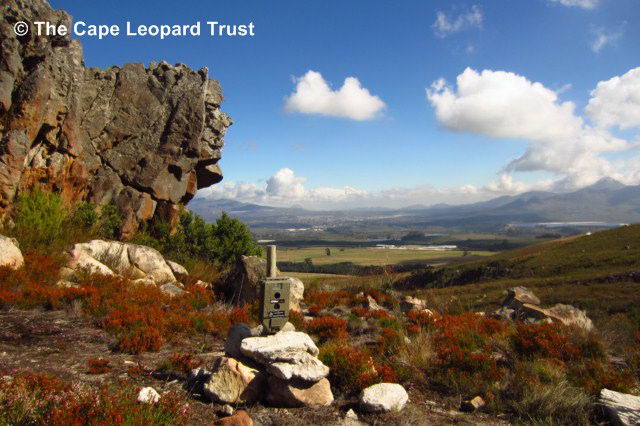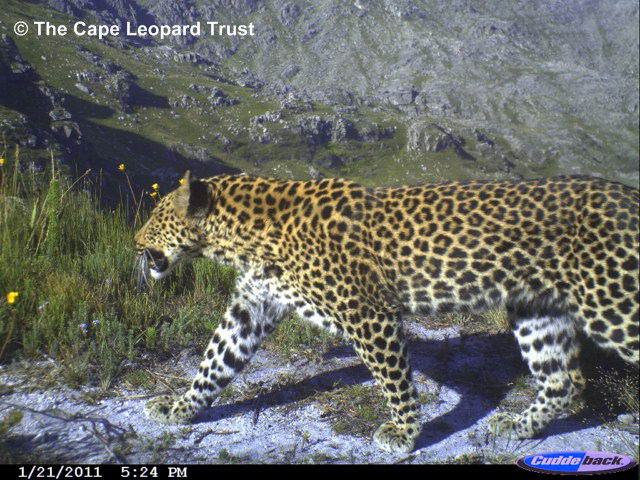The CLT Boland Project has been researching the elusive Cape leopard in the Boland mountains since March 2010. The project kicked off with a large-scale camera trapping survey using about 90 digital remote-sensing cameras. Cameras were placed along hiking trails, dirt roads and jeep tracks in CapeNature and City of Cape Town nature reserves, private land and water catchment areas from Bain’s Kloof southward along the Limietberg, Jonkershoek-, Hottentots-Holland and Kogelberg mountains to the coast at Betty’s Bay and Kleinmond.
Although leopards roam widely and are very adept at moving around in their rugged mountain habitat, they often utilise trails and roads – especially the males who need to regularly patrol and mark their large territories. Camera trap photos are ideal to individually identify leopards, since each leopard has a unique rosette pattern. By logging and comparing all leopard photos from the Boland study area, researchers Jeannie Hayward and Anita Meyer have identified more than 55 adult and sub-adult leopards in the Boland mountains. Using these photo data they have also been able to estimate rough home ranges of various individuals.

A remote-sensing camera on Oak Valley Estate
Camera traps are extremely useful to record the presence of secretive, nocturnal animals such as leopards, and to estimate population numbers. However, when investigating home range size, detailed habitat use and preference, and fine-scale movement patterns of far-ranging predators in extremely mountainous terrain, one needs GPS collar data. The current Boland collaring study uses such tracking data to study the effects of landscape fragmentation, human habitation and habitat alteration on leopard ecology and behaviour. These data will contribute to identifying immediate and long-term threats of concern to this iconic species and its habitat.
The sixth male Boland leopard was recently collared on Groenlandberg in the ElginValley. BM17 (Boland male #17), called Popeye, was captured on a section of the Green Mountain Trail on Oak Valley Estate. Popeye is a dominant male previously photographed at a number of locations within and adjacent to the Groenlandberg and Hottentots-Holland Nature Reserves. He weighed a healthy 37kg at his capture, and using tooth wear as an indication of age, he was estimated to be 7-9 years old. His tracking data show that he sometimes crosses the N2 near Houwhoek, and that he roams deep into the Hottentots-HollandMountains.

A camera trap photo of Popeye, BM17

Inspecting Popeye’s teeth to estimate his age
Popeye also has at least two known females in his range. Olive (BF14) has also been photographed on OakValley as well as a few other locations along the Groenlandberg, while Skye (BF12) roams the Hottentots-HollandMountains.


Olive (top) and Skye (bottom), two females in Popeye’s range
We would like to extend a massive thank you to Oak Valley Estate for providing accommodation and logistical support during the capture period. Without this kind of assistance from private landowners our job would be much more challenging. A big thank you also to AST Distribution for sponsoring valuable airtime for the Boland team’s satellite phone – an essential piece of equipment for working in remote mountainous areas without cellphone reception.
Boland greetings
Jeannie & Anita
















